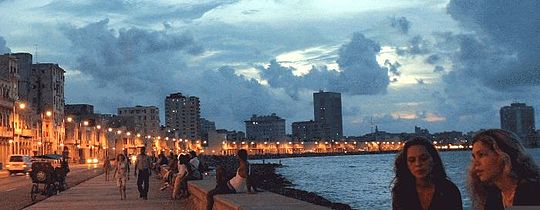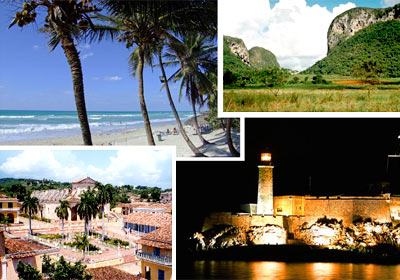The Malecón is perhaps the most universal symbol of a city with five centuries of history. The construction of a breakwater moved eight kilometers as Havana expanded from early last century. And on that wall now develop some of the most vibrant scenes of the city.
Deployed between two historic buildings, the tower of the CV, to the west, and the Castle of La Punta, east, receives between those two points a mix of historic buildings, monuments, street vendors, hotels, bars, restaurants, a stage of athletics, markets and a busy social life where fishermen, swimmers, lovers, musicians, brokers and knots of people sharing a multipurpose space.
Young people crowd on the weekends, a real evening party, the foot of the historic National Hotel, as the square of the height of Paseo. Between the two places, at the height of the street G, is the Casa de las Americas, a prestigious cultural institution founded in 1959 and located just meters from the monument to horse Calixto Garcia, national hero.
Many of the symbols of the city up to the edge of the road: as the monument to the victims of Maine (“who were slaughtered by the imperialist voracity in its eagerness to seize the island of Cuba,” reads the legend), who started the final dispute the Spanish colony, the Interests of the United States (and stunning forest Cuban flags in front), the modern era buildings like the Hotel Riviera, or the buildings to the height of Centro Habana, some restored architectural treasures.
Mayer Lansky, the gangster who reigned in Havana of business and play the 50, asked his driver to take him to the wee hours of the morning at the sea shore and certainly contemplate to think that moon “surrounded of clouds with very livid guts “as described José Lezama Lima in his masterpiece, Paradiso, the moon that could be seen from” the corner of the Malecon “.
The city contains, in the very edge of the sea, a variety of realities and history worth knowing if permitted by the waves, occasionally, completely burying one of the most universal avenues: the former Avenue Gulf Malecon Avenue today.
Sources: ElPais/Cobo/Excerpt/InternetPhoto/youtube/www.thecubanhistory.com
AVENIDA DEL GOLFO, LA HAVANA. THE MALECON.
The Cuban History, Arnoldo Varona, Editor
AVENIDA DEL GOLFO, LA HAVANA. EL MALECON.
El Malecón es quizá el símbolo más universal de una ciudad con cinco siglos de historia. La construcción de un rompeolas de ocho kilómetros avanzó a medida que La Habana se expandió desde principios del siglo pasado. Y sobre ese muro hoy se desarrollan algunas de las escenas más vibrantes de la ciudad.
Desplegado entre dos construcciones históricas, la torre de la Chorrera, al oeste, y el Castillo de La Punta, al este, acoge entre esos dos puntos una mezcla de edificios históricos, monumentos, vendedores ambulantes, hoteles, bares, restaurantes, un estadio de atletismo, mercadillos y una ajetreada vida social donde los pescadores, bañistas, amantes, músicos, corredores y corrillos de gente comparten un espacio multiusos.
Los jóvenes abarrotan los fines de semana, en una auténtica fiesta nocturna, los pies del histórico Hotel Nacional, igual que la plazoleta a la altura de Paseo. Entre ambos lugares, a la altura de la calle G, está la Casa de las Américas, prestigiosa institución cultural fundada en 1959 y situada a escasos metros del monumento a caballo de Calixto García, héroe nacional.
Muchos de los símbolos de la ciudad se levantan al borde de la calzada: como el monumento dedicado a las víctimas del Maine (“que fueron sacrificadas por la voracidad imperialista en su afán de apoderarse de la isla de Cuba”, reza la leyenda), que dio comienzo a la disputa final por la colonia española; la Oficina de Intereses de Estados Unidos (y el impresionante bosque de banderas cubanas de enfrente); los modernos edificios de la época, como el Hotel Riviera; o las construcciones a la altura de Centro Habana, algunas de ellas auténticas joyas arquitectónicas restauradas.
Mayer Lansky, el gángster que reinó en La Habana de los negocios y el juego de los años 50, pedía a su chófer que le llevara, a altas horas de la madrugada, a la orilla del mar para pensar y seguramente contemplar aquella luna “rodeada de nubes con las entrañas muy cárdenas”, como describió José Lezama Lima en su obra cumbre, Paradiso, la luna que se veía desde “el recodo del Malecón”.
La ciudad encierra, en el filo mismo del mar, toda una variedad de realidades e historia que merece la pena conocer siempre que lo permitan las olas que, de vez en cuando, sepultan por completo una de las avenidas más universales: la antigua Avenida del Golfo, hoy Avenida del Malecón.
Sources: ElPais/Cobo/Excerpt/InternetPhoto/youtube/www.thecubanhistory.com
AVENIDA DEL GOLFO, LA HAVANA. THE MALECON.
The Cuban History, Arnoldo Varona, Editor



 GULF AVENUE, LA HAVANA. THE MALECON (Video) * LA AVENIDA DEL GOLFO, LA HABANA. EL MALECON (Video).
GULF AVENUE, LA HAVANA. THE MALECON (Video) * LA AVENIDA DEL GOLFO, LA HABANA. EL MALECON (Video).
